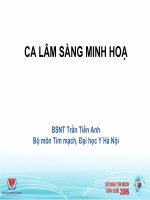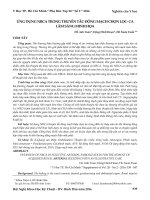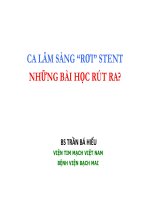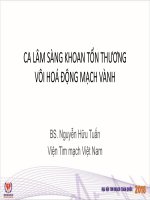Ca lâm sàng bs ckii tạ bình minh
Bạn đang xem bản rút gọn của tài liệu. Xem và tải ngay bản đầy đủ của tài liệu tại đây (1.39 MB, 29 trang )
<span class="text_page_counter">Trang 1</span><div class="page_container" data-page="1">
<b>Ca lâm sàng BS.CKII. Tạ Bình Minh </b>
<b>Khoa nội tiết – Bệnh viện Chợ Rẫy </b>
EM-VN-103058
</div><span class="text_page_counter">Trang 2</span><div class="page_container" data-page="2"><b>Bệnh sử </b>
• BN nam, 56 tuổi, nhân viên ngân hàng (ngồi nhiều)
• Cách đây 20 năm, bn khát nước, không sụt cân, cảm giác sức khỏe kém đi khám tổng quát phát hiện ĐTĐ.
• Điều trị rất nhiều nơi/17 năm (thay đổi công việc, nơi làm)
</div><span class="text_page_counter">Trang 3</span><div class="page_container" data-page="3"><b>Bệnh sử (tt) </b>
• Thời gian gần đây, bn cơng việc ổn định, theo dõi đường huyết tại nhà thấy cao, muốn được kiểm tra tình trạng sức khỏe
• Tiền căn:
• Phát hiện THA cách đây 10 năm • Mẹ và chị ruột bị ĐTĐ
• Bn khẳng định tập thể dục (chạy bộ, xe đạp) 1 tiếng mỗi ngày • Khơng có thói quen nhậu, chỉ uống xã giao
</div><span class="text_page_counter">Trang 4</span><div class="page_container" data-page="4">
<b>Khám </b>
• Cao 1.65 m, nặng 57.8 kg BMI 21.23 • HA 136/71 mmHg, mạch 82 l/p
• Khám các cơ quan chưa ghi nhận bất thường • Kết quả xét nghiệm cũ bn mang theo (T12/2022)
ĐH 7.81 mmol/L; HbA1c 7.1% eGFR 63 mL/phút/1.73 m2
A/C niệu 36.97 mg/g Ion đồ bình thường
</div><span class="text_page_counter">Trang 5</span><div class="page_container" data-page="5">THEO DÕI SAU 01 TUẦN
</div><span class="text_page_counter">Trang 7</span><div class="page_container" data-page="7"><b>XIN Ý KIẾN HƯỚNG XỬ LÝ TIẾP THEO </b>
7
</div><span class="text_page_counter">Trang 8</span><div class="page_container" data-page="8"><b>Tham luận ca lâm sàng </b>
<b>Ths.BS. Nguyễn Hữu Mân </b>
</div><span class="text_page_counter">Trang 9</span><div class="page_container" data-page="9"><b>FOR INTERNAL USE ONLY. STRICTLY CONFIDENTIAL. DO NOT COPY, DETAIL OR DISTRIBUTE EXTERNALLY. </b>
<small>9 </small>
<b>Việc không tuân thủ điều trị giải thích 75% việc kém hiệu quả trong điều kiện thực tế </b>
*Under typical trial circumstances
BL, baseline; HbA<sub>1c</sub>, glycosylated haemoglobin
<i>Edelman SV et al. Diabetes Care 2017;40:1425 </i>
<b>trong điều kiện </b>
<b>trống điều trị </b>
</div><span class="text_page_counter">Trang 10</span><div class="page_container" data-page="10"><b>FOR INTERNAL USE ONLY. STRICTLY CONFIDENTIAL. DO NOT COPY, DETAIL OR DISTRIBUTE EXTERNALLY. </b>
<small>10 </small>
<b>Số viên thuốc mỗi ngày là cực kỳ quan trọng với việc tuân thủ điều trị </b>
<small>aOnce daily versus three-times daily, P = 0.008. bOnce daily versus four-times daily, P < 0.001. cTwice daily versus four-times daily, P < 0.001. Points show mean and standard deviation Garcua-Perez et al. Diabetes Ther. 2013; 4(2):175-194. </small>
</div><span class="text_page_counter">Trang 11</span><div class="page_container" data-page="11"><b>FOR INTERNAL USE ONLY. STRICTLY CONFIDENTIAL. DO NOT COPY, DETAIL OR DISTRIBUTE EXTERNALLY. </b>
<small>11 </small>
<b>Lợi ích của việc kết hợp liều cố định: Tầm quan trọng của việc BN tuân thủ các liệu pháp điều trị ĐTĐ</b>
<small>*Patients initiating index oral diabetes medication therapy with sulfonylurea, metformin, or metformin plus sulfonylurea HbA1c, glycosylated haemoglobin </small>
<b>Cứ tăng 10% tỷ lệ tuân thủ điều trị sẽ dẫn đến giảm HbA1c 0,1% </b>
</div><span class="text_page_counter">Trang 12</span><div class="page_container" data-page="12"><b>FOR INTERNAL USE ONLY. STRICTLY CONFIDENTIAL. DO NOT COPY, DETAIL OR DISTRIBUTE EXTERNALLY. </b>
<small>12 </small>
*25 unique RCTs from 63 publications and 3 clinical study reports
<b>Kết hợp empa/lina trên nền metformin cho thấy khả năng giảm HbA1c đáng kể so với các liệu pháp khác </b>
<small>SLR included RCTs on adults (age >18 years) with T2DM and uncontrolled HbA1c (HbA1c >7.0%) while on metformin, who were administered any of the approved oral doses of SGLT-2 inhibitors, DPP-4 inhibitors, as single or dual initiation therapies adjunctive to metformin. Studies evaluating injectable AHA, insulin, diet, and exercise interventions were excluded. Efficacy outcomes included change from baseline in HbA1c, weight, systolic blood pressure (SBP), diastolic blood pressure (DBP), and proportion of patients achieving HbA1c >7% at 24–26 weeks of follow-up. </small>
<small>Lautsch et al. Comparative Efficacy of Dual and Single Initiation of Add-On Oral Antihyperglycemic Agents in Type 2 Diabetes Uncontrolled on Metformin Alone: A Systematic Literature Review and Network Meta- Analysis. Diabetes Ther (2021) 12:389–418 </small>
</div><span class="text_page_counter">Trang 13</span><div class="page_container" data-page="13"><b>Long-term effectiveness and safety of quadruple combination therapy </b>
<b>in patients with type 2 diabetes: 3-year prospective observational </b>
<b>study </b>
<i>Ku EJ et al. Diabetes Res Clin Pract. 2021; 182:109123 </i>
</div><span class="text_page_counter">Trang 14</span><div class="page_container" data-page="14"><b>FOR INTERNAL USE ONLY. STRICTLY CONFIDENTIAL. DO NOT COPY, DETAIL OR DISTRIBUTE EXTERNALLY. </b>
<small>14 </small>
<b>Phần lớn BN điều trị với empagliflozin đạt mức HbA1c mục tiêu so với dapagliflozin sau 36 tháng </b>
14
Ku EJ et al. Diabetes Res Clin Pract 2021
<b>More patients treated with empagliflozin achieved HbA1c target compared to </b>
</div><span class="text_page_counter">Trang 15</span><div class="page_container" data-page="15"><b>Cảm ơn đã chú ý theo dõi </b>
</div><span class="text_page_counter">Trang 16</span><div class="page_container" data-page="16"><b>FOR INTERNAL USE ONLY. STRICTLY CONFIDENTIAL. DO NOT COPY, DETAIL OR DISTRIBUTE EXTERNALLY. </b>
<b>Góc nhìn tim mạch </b>
TS.BS. Đinh Đức Huy Bệnh viện Tim Tâm Đức
1.Bệnh nhân có thuộc nhóm nguy cơ
</div><span class="text_page_counter">Trang 17</span><div class="page_container" data-page="17">European Heart Journal 2021: 42(34), 3227–3337
</div><span class="text_page_counter">Trang 19</span><div class="page_container" data-page="19"><b>ESC 2023: đánh giá nguy cơ tim mạch cho bệnh nhân đái tháo đường </b>
In patients with T2DM without symptomatic ASCVD or severe TOD, it
is recommended to estimate 10-year CVD risk via SCORE2-Diabetes. <b><sup>I </sup><sup>B </sup></b>
2023 ESC Guidelines for the management of cardiovascular disease in patients with diabetes (European Heart Journal; 2023 – doi:10.1093/eurheartj/ehad192)
<b>Severe TOD: </b>
• eGFR <45 mL/min/1.73 m2 irrespective of albuminuria; or
• eGFR 45–59 mL/min/1.73 m2 and microalbuminuria (UACR 30–300 mg/g; stage A2); or • Proteinuria (UACR >300 mg/g; stage A3); or
• Presence of microvascular disease in at least three different sites [e.g. microalbuminuria (stage A2) plus retinopathy plus neuropathy].
</div><span class="text_page_counter">Trang 20</span><div class="page_container" data-page="20"><b>From SCORE2 to SCORE2-Diabetes </b>
</div><span class="text_page_counter">Trang 21</span><div class="page_container" data-page="21">~230K individual with type 2 diabetes and information on
age at diagnosis, HbA1c and eGFR
<b>SCORE2-Diabetes </b>
<b>Internal and external validation across Europe </b>
<b>www.escardio.org/guidelines </b>
<sup>2023 ESC Guidelines for the management of cardiovascular disease in patients with diabetes </sup><sub>(European Heart Journal; 2023 – doi:10.1093/eurheartj/ehad192) </sub></div><span class="text_page_counter">Trang 22</span><div class="page_container" data-page="22">2023 ESC Guidelines for the management of cardiovascular disease in patients with diabetes (European Heart Journal; 2023 – doi:10.1093/eurheartj/ehad192)
</div><span class="text_page_counter">Trang 23</span><div class="page_container" data-page="23"><b>Recommendations Class Level </b>
It is recommended to assess medical history and the presence of symptoms
suggestive of <b>ASCVD</b> in patients with diabetes. <b><sup>I </sup><sup>B </sup></b> Systematic survey for HF symptoms and/or signs of <b>HF</b> is recommended at each
clinical encounter in all patients with diabetes. <b><sup>I </sup><sup>C </sup></b>
<b>Recommendation Class Level </b>
It is recommended that patients with diabetes are routinely screened for <b>kidney </b>
<b>disease</b> by assessing eGFR defined by CKD-EPI and UACR. <b><sup>I </sup><sup>B </sup></b>
2023 ESC Guidelines for the management of cardiovascular disease in patients with diabetes (European Heart Journal; 2023 – doi:10.1093/eurheartj/ehad192)
<b>Đánh giá bệnh tim-thận ở bệnh nhân đái tháo đường </b>
</div><span class="text_page_counter">Trang 24</span><div class="page_container" data-page="24"><b>FOR INTERNAL USE ONLY. STRICTLY CONFIDENTIAL. DO NOT COPY, DETAIL OR DISTRIBUTE EXTERNALLY. </b>
<b>Giai đoạn có nguy cơ suy tim- bệnh nhân đái tháo đường </b>
<i>Heidenreich PA, et al. J Card Fail 2022</i>
<small>2022 AHA/ACC/HFSA Guideline for the Management of Heart Failure – </small>
</div><span class="text_page_counter">Trang 25</span><div class="page_container" data-page="25"><b>FOR INTERNAL USE ONLY. STRICTLY CONFIDENTIAL. DO NOT COPY, DETAIL OR DISTRIBUTE EXTERNALLY. </b>
<small>2022 AHA/ACC/HFSA Guideline for the Management of Heart Failure – DOI: 10.1016/j.cardfail.2022.02.010 </small>
<i>Heidenreich PA, et al. J Card Fail 2022 </i>
<b>ACC/AHA/HFSA 2022: Khuyến cáo phòng ngừa tiên phát suy tim </b>
<b>1A</b><sup>In patients with hypertension, </sup><sub>accordance with GDMT for hypertension to prevent symptomatic HF</sub><b><sup>blood pressure </sup></b><sup>should be controlled in </sup>
In patients with type 2 diabetes and either established cardiovascular disease or at high cardiovascular risk, <b>SGLT2i </b>should be used to prevent hospitalizations for HF
In the general population, <b>healthy lifestyle habits </b>such as regular
physical activity, maintaining normal weight, healthy dietary patterns, and avoiding smoking are helpful to reduce future risk of HF
For patients at risk of developing HF, <b>natriuretic peptide biomarker</b>–
<b>based screening followed by team-based care, including a cardiovascular </b>
specialist optimizing GDMT, can be useful to prevent the development of LV dysfunction (systolic or diastolic) or new-onset
<b>2aB - NR</b><sup>In the general population, </sup><sub>be useful to estimate subsequent risk of incident HF</sub><b><sup>validated multivariable risk scores </sup></b><sup>can </sup>
</div><span class="text_page_counter">Trang 26</span><div class="page_container" data-page="26"><b>FOR INTERNAL USE ONLY. STRICTLY CONFIDENTIAL. DO NOT COPY, DETAIL OR DISTRIBUTE EXTERNALLY. </b>
<b>ESC 2023: SGLT2i là lựa chọn đầu tay cho bệnh nhân ĐTĐ </b>
<b>có nguy cơ cao hoặc bệnh tim mạch – thận </b>
<small>European Heart Journal (2023) 00, 1–98 </small>
</div><span class="text_page_counter">Trang 27</span><div class="page_container" data-page="27"><b>Chỉ định của Empagliflozin tại Việt Nam </b>
<small>Tờ hướng dẫn sử dụng thuốc empagliflozin tại Việt Nam, 05/2023 </small>
<b>Kiểm soát đường huyết </b>
<b>Giảm nguy cơ tử vong tim mạch ở bệnh nhân </b>
trưởng thành đái tháo đường típ 2 và có sẵn bệnh
<b>Giảm nguy cơ tử vong tim mạch và nhập viện do suy tim ở bệnh nhân trưởng thành suy tim </b>
• Liều khởi đầu: empagliflozin là 10 mg 1 lần/ngày
• Có thể tăng liều lên 25 mg 1 lần/ngày nếu cần kiểm soát đường huyết chặt chẽ hơn
</div><span class="text_page_counter">Trang 29</span><div class="page_container" data-page="29"><small>SC-MY-02326 </small>









